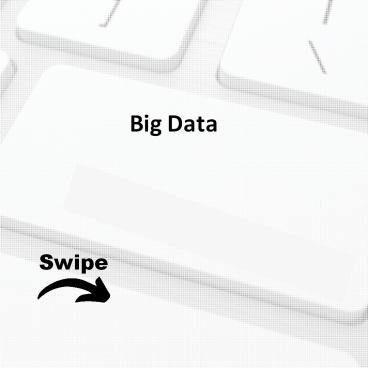Big Data PowerPoint PPT Presentation
Title: Big Data
1
Big Data
Swipe
2
Big Data
Big data is a combination of structured,
semistructured and unstructured data collected by
organizations that can be mined for information
and used in machine learning projects, predictive
modeling and other advanced analytics
applications. Systems that process and store big
data have become a common component of data
management architectures in organizations,
combined with tools that support big data
analytics uses.
3
Big data is often characterized by the three V's
The large volume of data in many environments
The wide variety of data types frequently stored
in big data systems and The velocity at which
much of the data is generated, collected and
processed.
4
Importance of big data
- Companies use big data in their systems to
improve operations, provide better customer
service, create personalized marketing campaigns
and take other actions that, ultimately, can
increase revenue and profits. Businesses that
use it effectively hold a potential competitive
advantage over those that don't because they're
able to make faster and more informed business
decisions.
5
Example
Big data provides valuable insights into
customers that companies can use to refine their
marketing, advertising and promotions in order
to increase customer engagement and conversion
rates. Both historical and real-time data can be
analyzed to assess the evolving preferences of
consumers or corporate buyers, enabling
businesses to become more responsive to customer
wants and needs.
6
How big data is used by organizations?
In the energy industry, big data helps oil and
gas companies identify potential drilling
locations and monitor pipeline operations
likewise, utilities use it to track electrical
grids. Financial services firms use big data
systems for risk management and real-time
analysis of market data. Manufacturers and
transportation companies rely on big data to
manage their supply chains and optimize delivery
routes. Other government uses include emergency
response, crime prevention and smart city
initiatives.
7
How big data is stored and processed?
Big data is often stored in a data lake. While
data warehouses are commonly built on relational
databases and contain structured data only,
data lakes can support various data types and
typically are based on Hadoop clusters, cloud
object storage services, NoSQL databases or
other big data platforms.
8
Big data management technologies
Hadoop, an open source distributed processing
framework released in 2006, initially was at the
center of most big data architectures.
The development of Spark and other processing
engines pushed MapReduce, the engine built into
Hadoop, more to the side. The result is an
ecosystem of big data technologies that can be
used for different applications but often are
deployed together.
9
Big data management technologies
Big data platforms and managed services offered
by IT vendors combine many of those technologies
in a single package, primarily for use in the
cloud. Currently, that includes these offerings,
listed alphabetically Amazon EMR (formerly
Elastic MapReduce) Cloudera Data Platform Google
Cloud Dataproc HPE Ezmeral Data Fabric (formerly
MapR Data Platform) Microsoft Azure HDInsight
10
Examples of big data in organization
- In an organization, developing a big data
strategy - requires an understanding of business goals and
the data that's currently available to use, plus
an - assessment of the need for additional data to
help meet the objectives. The next steps to take
include the following - prioritizing planned use cases and applications
identifying new systems and tools that are - needed
- creating a deployment roadmap and evaluating
internal skills to see if retraining or hiring
are required.
11
Topics for next Post
Classification and regression trees
(CART) Neural Networks Stay Tuned with

